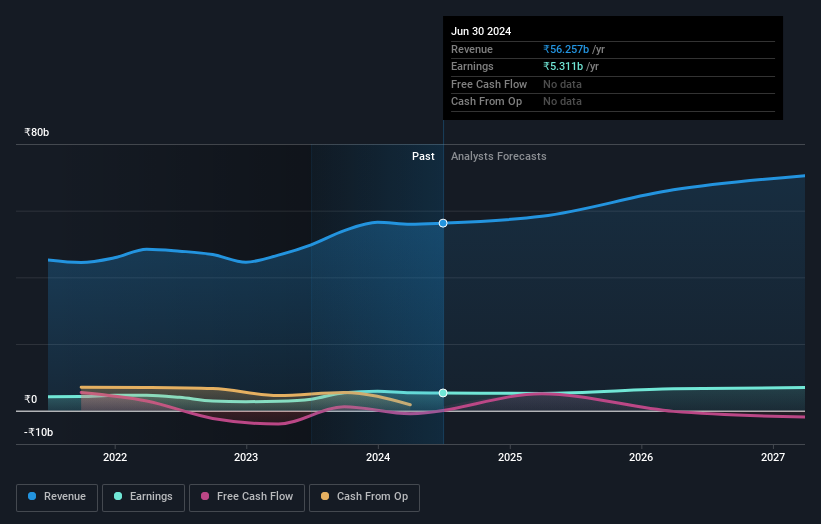Optimism for Balrampur Chini Mills (NSE:BALRAMCHIN) has grown this past week, despite five-year decline in earnings
Long term investing can be life changing when you buy and hold the truly great businesses. And we've seen some truly amazing gains over the years. To wit, the Balrampur Chini Mills Limited (NSE:BALRAMCHIN) share price has soared 352% over five years. This just goes to show the value creation that some businesses can achieve. Also pleasing for shareholders was the 58% gain in the last three months. This could be related to the recent financial results, released recently - you can catch up on the most recent data by reading our company report.
The past week has proven to be lucrative for Balrampur Chini Mills investors, so let's see if fundamentals drove the company's five-year performance.
See our latest analysis for Balrampur Chini Mills
To paraphrase Benjamin Graham: Over the short term the market is a voting machine, but over the long term it's a weighing machine. One imperfect but simple way to consider how the market perception of a company has shifted is to compare the change in the earnings per share (EPS) with the share price movement.
Balrampur Chini Mills' earnings per share are down 0.2% per year, despite strong share price performance over five years.
By glancing at these numbers, we'd posit that the decline in earnings per share is not representative of how the business has changed over the years. Therefore, it's worth taking a look at other metrics to try to understand the share price movements.
The modest 0.5% dividend yield is unlikely to be propping up the share price. On the other hand, Balrampur Chini Mills' revenue is growing nicely, at a compound rate of 3.5% over the last five years. In that case, the company may be sacrificing current earnings per share to drive growth.
The company's revenue and earnings (over time) are depicted in the image below (click to see the exact numbers).

We know that Balrampur Chini Mills has improved its bottom line lately, but what does the future have in store? You can see what analysts are predicting for Balrampur Chini Mills in this interactive graph of future profit estimates.
What About Dividends?
When looking at investment returns, it is important to consider the difference between total shareholder return (TSR) and share price return. Whereas the share price return only reflects the change in the share price, the TSR includes the value of dividends (assuming they were reinvested) and the benefit of any discounted capital raising or spin-off. It's fair to say that the TSR gives a more complete picture for stocks that pay a dividend. In the case of Balrampur Chini Mills, it has a TSR of 376% for the last 5 years. That exceeds its share price return that we previously mentioned. This is largely a result of its dividend payments!
A Different Perspective
It's nice to see that Balrampur Chini Mills shareholders have received a total shareholder return of 52% over the last year. Of course, that includes the dividend. That's better than the annualised return of 37% over half a decade, implying that the company is doing better recently. Someone with an optimistic perspective could view the recent improvement in TSR as indicating that the business itself is getting better with time. It's always interesting to track share price performance over the longer term. But to understand Balrampur Chini Mills better, we need to consider many other factors. For instance, we've identified 3 warning signs for Balrampur Chini Mills (1 makes us a bit uncomfortable) that you should be aware of.
Of course Balrampur Chini Mills may not be the best stock to buy. So you may wish to see this free collection of growth stocks.
Please note, the market returns quoted in this article reflect the market weighted average returns of stocks that currently trade on Indian exchanges.
Have feedback on this article? Concerned about the content? Get in touch with us directly. Alternatively, email editorial-team (at) simplywallst.com.
This article by Simply Wall St is general in nature. We provide commentary based on historical data and analyst forecasts only using an unbiased methodology and our articles are not intended to be financial advice. It does not constitute a recommendation to buy or sell any stock, and does not take account of your objectives, or your financial situation. We aim to bring you long-term focused analysis driven by fundamental data. Note that our analysis may not factor in the latest price-sensitive company announcements or qualitative material. Simply Wall St has no position in any stocks mentioned.
 Index Options
Index Options CME Group
CME Group Nasdaq
Nasdaq Cboe
Cboe TradingView
TradingView Wall Street Journal
Wall Street Journal